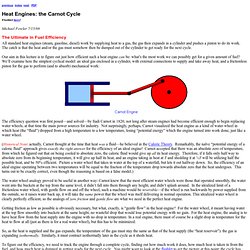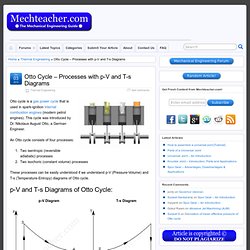

13.3 The Carnot Cycle and the Efficiency of Engines. Heat Engines: the Carnot Cycle. Flashlet here!

Michael Fowler 7/15/08 The Ultimate in Fuel Efficiency All standard heat engines (steam, gasoline, diesel) work by supplying heat to a gas, the gas then expands in a cylinder and pushes a piston to do its work. The catch is that the heat and/or the gas must somehow then be dumped out of the cylinder to get ready for the next cycle. Our aim in this lecture is to figure out just how efficient such a heat engine can be: what’s the most work we can possibly get for a given amount of fuel? The efficiency question was first posed—and solved—by Sadi Carnot in 1820, not long after steam engines had become efficient enough to begin replacing water wheels, at that time the main power sources for industry. (Historical Note: actually, Carnot thought at the time that heat was a fluid—he believed in the Caloric Theory.
Getting friction as low as possible is obviously necessary, but what, exactly, is “gentle flow” in the heat engine? Step 1: Isothermal Expansion in the (P, V) plane. is just. Carnot Cycle. Animated Engines - Home. Animation How Otto cycle works. ✔ Otto_cycle. Otto Cycle - Processes with p-V and T-s Diagrams « Mechteacher.com. Otto cycle is a gas power cycle that is used in spark-ignition internal combustion engines (modern petrol engines).

This cycle was introduced by Dr. Nikolaus August Otto, a German Engineer. An Otto cycle consists of four processes: Two isentropic (reversible adiabatic) processesTwo isochoric (constant volume) processes These processes can be easily understood if we understand p-V (Pressure-Volume) and T-s (Temperature-Entropy) diagrams of Otto cycle. p-V and T-s Diagrams of Otto Cycle: Note: In the above diagrams, p → Pressure V → Volume T → Temperature s → Entropy Vc → Clearance Volume Vs → Stroke Volume Processes in Otto Cycle: As stated earlier, Otto cycle consists of four processes.
Process 1-2: Isentropic compression In this process, the piston moves from bottom dead centre (BDC) to top dead centre (TDC) position. Process 2-3: Constant Volume Heat Addition: Process 2-3 is isochoric (constant volume) heat addition process. In this process, Heat Supplied = mCv(T3 – T2) where, m → Mass In process 4-1, Otto Engine. Description The behavior of a gasoline engine (the kind used in automobiles of today) can be approximated by making the following assumptions: The working substance is an ideal gas (in reality it is a gasoline - air mixture which is combining chemically).

All processes are quasi static (mechanical equilibrium:no unbalanced forces, Thermal equilibrium: no temperature differences between parts of the system and chemical equilibrium: no chemical reactions). There is no friction. The above simulation shows the cycle and your choice of either the PV diagram or the TV diagram for each of the six processes of the engine: Ignition: The spark plug ignites the gas/air mixture. At this point the cycle starts over.
Credits: Script by Wolfgang Christian. Description of the cycles came from 'Heat and Thermodynamics', Zemansky and Dittman. Engine Simulation. Otto cycle simulator using a RIA.